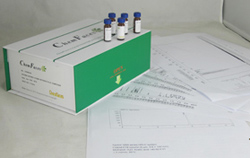Hot Products



| Catalog No. | Information |
| CFN97101 | Torachrysone 8-O-glucoside Torachryson-8-O-glucoside shows alpha-glucosidase inhibitory activities, it may be used for the management of type 2 diabetes. |
| CFN96316 | Torilin Torilin is an inhibitor of testosterone 5 alpha-reductase, it (IC50 = 31.7 +/- 4.23 microM) shows a stronger inhibition of 5 alpha-reductase than alpha-linolenic acid (IC50 = 160.3 +/- 24.62 microM) but is weaker than finasteride (IC50 = 0.38 +/- 0.06 microM). Torilin has immunomodulatory, hepatoprotective, and anti-inflammatory properties, it inhibits inflammation by limiting TAK1-mediated MAP kinase and NF-κB activation, it can attenuate arthritis severity, modify leukocyte activations in dLNs or joints, and restore serum and splenocyte cytokine imbalances. Torilin inhibits melanin production in alpha-melanocyte stimulating hormone-activated B16 melanoma cells, with an IC(50) value of 25 microM. Torilin shows excellent antimicrobial activity against Bacillus subtilis ATCC 6633 spores and vegetative cells. Torilin has a potent anti-angiogenic activity both in vivo and in vitro, and it may have a strong activity to suppress tumorigenesis by inhibition of tumor invasion, it reverses multidrug-resistance in cancer cells, it can potentiate the cytotoxicities of adriamycin, vinblastine, taxol and colchicine against multidrug-resistant KB-V1 and MCF7/ADR cells. |
| CFN99434 | Tormentic acid Tormentic acid has anticancer, anti-inflammatory, anti-atherogenic , anti-allodynic, and hepatoprotective properties, it can inhibit markedly the neuropathic allodynia induced by partial ligation of the sciatic nerve. Tormentic acid potently inhibits the production of nitric oxide (NO) in RAW 264.7 cells, also suppresses the LPS-stimulated degradation and phosphorylation of inhibitor of kappa B-α (IκB-α), suggests that the anti-inflammatory activity of TA is associated with the down-regulation of iNOS, COX-2, and TNF-α through the negative regulation of the NF-κB pathway in RAW 264.7 cells. |
| CFN97733 | Totarol Totarol has anti-bacteria effect by restraining bacterial growth by perturbing the cell division and proliferation, including several pathogenic Gram-positive bacteria, mycobacterium tuberculosis. Totarol treatment leads to metabolic shutdown by repressing the major central metabolic dehydrogenases in B. subtilis. |
| CFN90598 | Trachelogenin Trachelogenin has antiproliferative effect, the mechanism is related to affect the phosphorylation of key proteins such as β-Catenin, c-Myc and GSK3 in the β-Catenin signaling pathway in a concentration-dependent manner. |
| CFN90597 | Tracheloside Tracheloside significantly decreases the activity of alkaline phosphatase (AP), an estrogen-inducible marker enzyme, with an IC(50) value of 0.31 microg/ml, a level of inhibition comparable to that of tamoxifen (IC(50) = 0.43 microg/ml). |
| CFN92366 | Trametenolic acid Trametenolic acid is a cytotoxic agent.It exhibits a mode of mixed inhibition with a K I of 0.9 μM, K IS of 0.5 μM, and an IC50 of 7.25 μM.Trametenolic acid and Betulin as a new candidate of potent tyrosinase inhibitors, can decrease tyrosinase activity and melanin content. |
| CFN60051 | Trametinib (GSK1120212) Trametinib (GSK1120212) is a highly specific and potent MEK1/2 inhibitor with IC50 of 0.92 nM/1.8 nM in cell-free assays, no inhibition of the kinase activities of c-Raf, B-Raf, ERK1/2. Trametinib activates autophagy and induces apoptosis. |
| CFN90569 | Tranexamic acid Tranexamic acid is an antifibrinolytic for blocking lysine-binding sites of plasmin and elastase-derived plasminogen fragments with IC50 of 5 mM. Tranexamic acid appears to be a promising drug for the prevention and treatment of PPH after both vaginal and caesarean delivery, it can reduce mortality due to traumatic bleeding by a third, without apparent safety issues. |
| CFN70220 | trans-2-Hexen-1-ol trans-2-Hexen-1-ol could be attractants for Asias halodendri adults. |